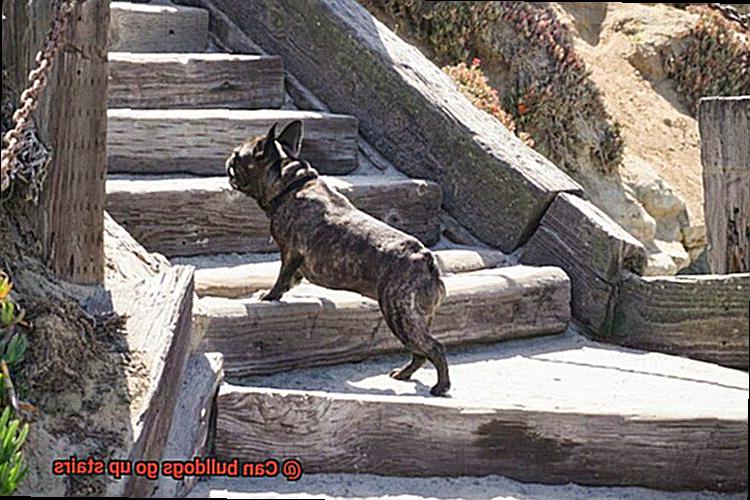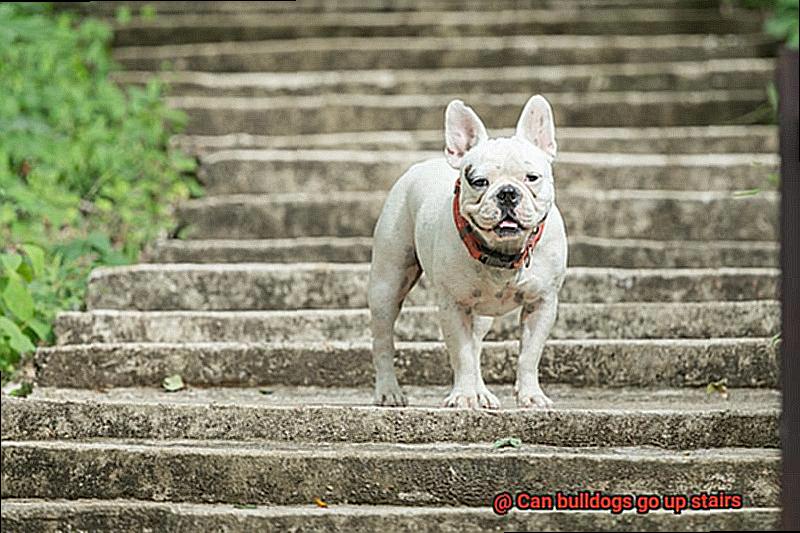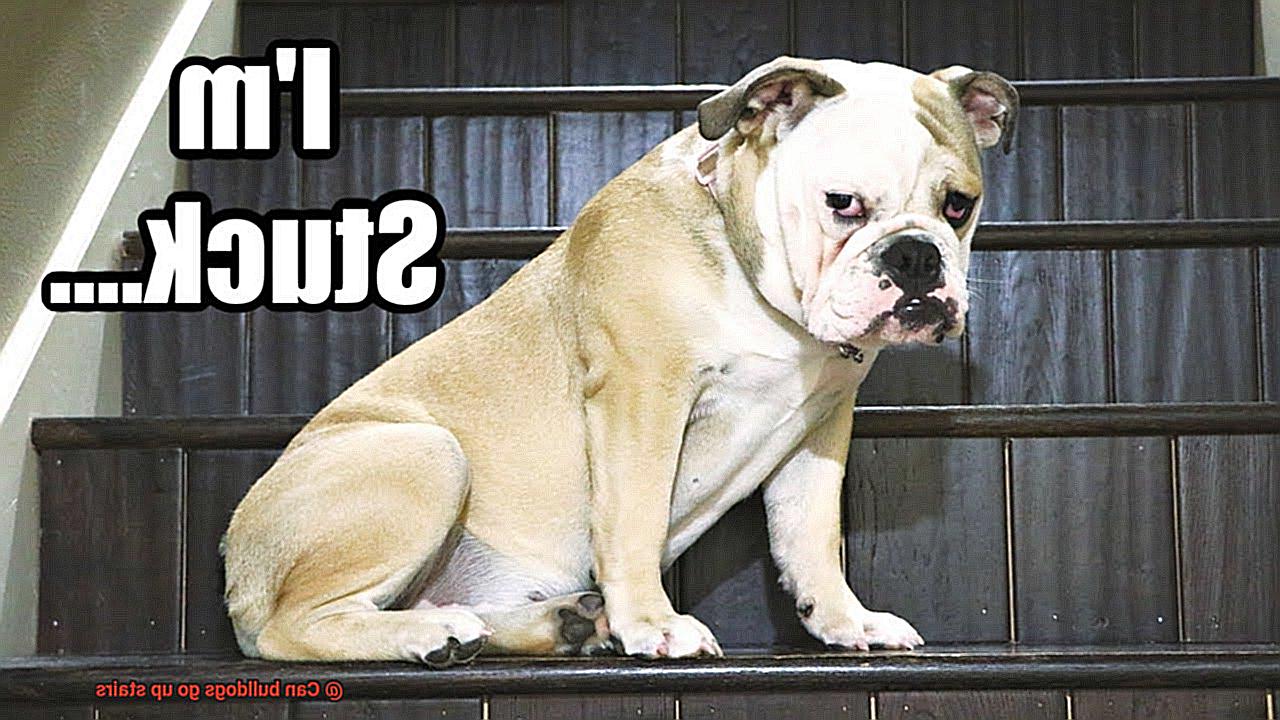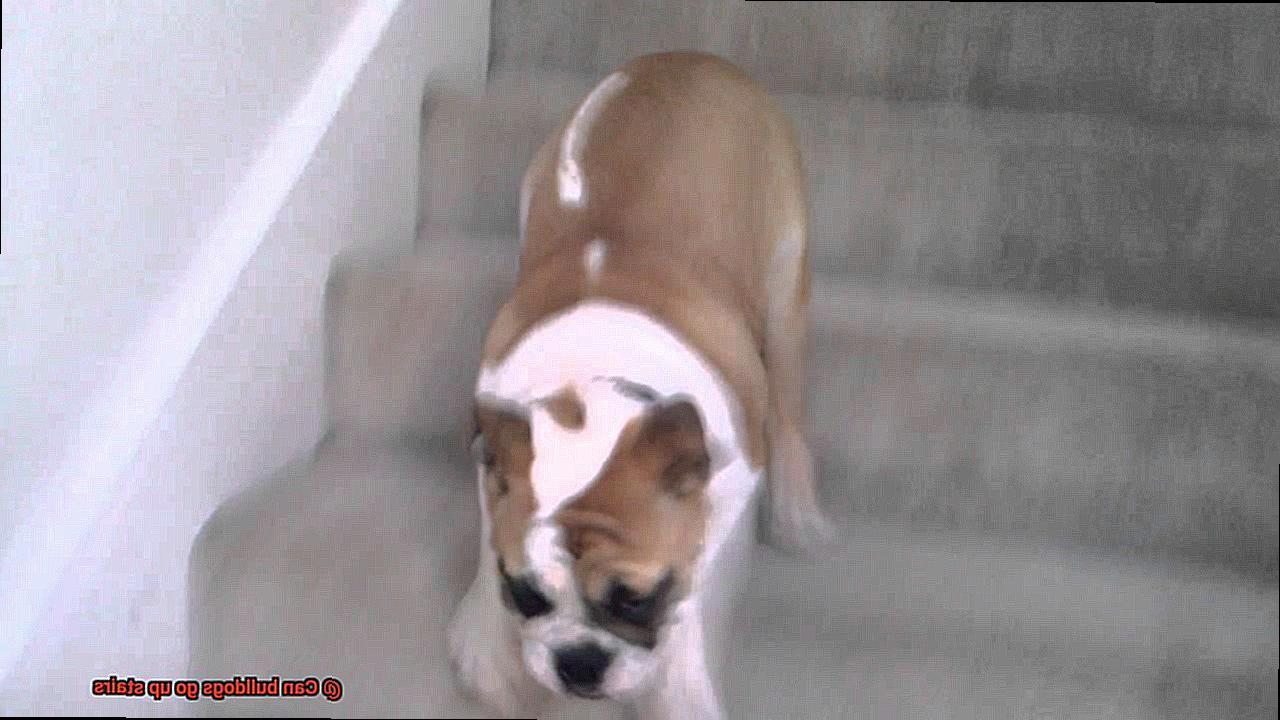Can bulldogs go up stairs?
Get ready to embark on a fascinating journey as we unravel a question that has puzzled many: Can bulldogs conquer stairs? These adorable, robust canines have stolen countless hearts with their squishy faces and lovable personalities. However, it’s no secret that bulldogs come with some anatomical quirks that may cast doubt on their stair-climbing abilities.
In this captivating blog post, we’ll dive deep into the topic with equal parts expertise and curiosity, shedding light on the intriguing world of bulldogs and stairs. Prepare to have your assumptions challenged and your knowledge expanded as we uncover the truth about whether these resilient creatures can triumph over the vertical challenge. So, sit back, relax, and join us as we unlock the mysteries of bulldogs defying gravity, one step at a time.
The Unique Physique of Bulldogs and Its Challenges
Contents
- 1 The Unique Physique of Bulldogs and Its Challenges
- 2 Health Issues That Affect a Bulldog’s Ability to Climb Stairs
- 3 Overcoming Fear and Difficulty with Stairs
- 4 Training Tips for Teaching Bulldogs to Climb Stairs
- 5 Using Treats and Toys as Incentives for Bulldog Training
- 6 Providing Support and Assistance on the Stairs
- 7 Monitoring a Bulldog’s Physical Well-Being During Training
- 8 Conclusion
With their stocky build, low-slung body, and wide chest, Bulldogs have a look that sets them apart from other dog breeds. However, their distinctive physique also comes with its own set of challenges, especially when it comes to activities like climbing stairs.
One of the main challenges Bulldogs face when it comes to stairs is their short legs. Compared to dogs with longer legs, Bulldogs can find climbing stairs more difficult. The steep incline and narrow steps can make it hard for them to maintain balance and coordinate their movements. It’s like asking someone with short legs to climb a mountain – it’s not an easy task.
But that’s not all – Bulldogs also have brachycephalic (flat) faces, which can lead to breathing difficulties and reduced stamina. This means that climbing stairs can be physically demanding for them. Imagine trying to catch your breath while climbing a flight of stairs – it’s not the easiest thing to do.
Adding to the challenge is the potential weight gain that Bulldogs are prone to. Their heavy bodies can put extra strain on their joints and muscles, making it even harder for them to navigate stairs without experiencing discomfort or fatigue.
So, what can you do as a responsible Bulldog owner? First and foremost, awareness is key. Understanding the unique challenges your Bulldog faces when it comes to stairs can help you take appropriate measures to ensure their safety and well-being.

Consider providing alternative options for your Bulldog to access different levels of your house without having to use stairs. Ramps or lifts can be great alternatives that are easier on their bodies. Regular exercise and weight management are also essential for maintaining the overall health and mobility of Bulldogs.
While some Bulldogs may be able to navigate stairs with practice and assistance, it’s important to monitor their behavior and well-being during such activities. If your Bulldog shows signs of stress, difficulty breathing, or physical discomfort when attempting to climb stairs, it’s best to seek guidance from a veterinarian or professional dog trainer.
Health Issues That Affect a Bulldog’s Ability to Climb Stairs
Let’s face it, climbing stairs is not their forte. If you’re a proud Bulldog owner, you might have noticed that your furry friend struggles with this vertical challenge. But fear not. In this guide, we’ll explore the health issues that can affect a Bulldog’s ability to climb stairs and provide some paw-some solutions to help them conquer those steps.
Brachycephalic Anatomy:
Picture this – a Bulldog with its cute, smushed-in face panting heavily after climbing just a few steps. This is because their short-nosed anatomy makes it harder for them to breathe properly, especially during exertion. Climbing stairs can put strain on their already compromised respiratory system. So, what can you do? Consider installing ramps or lifts to provide alternative means of access between levels.
Hip Dysplasia:
Hip dysplasia is a common health issue in Bulldogs that affects their hip joints, causing pain and stiffness. Climbing stairs can exacerbate these symptoms and make it even more challenging for your pup. To alleviate their discomfort, consult your veterinarian for treatment options such as medication, physical therapy, or joint supplements. Additionally, consider providing your Bulldog with a comfortable orthopedic bed to support their joints.
Obesity:
Bulldogs are prone to packing on the pounds, which can make climbing stairs an uphill battle (pun intended.). Excess weight puts strain on their joints and muscles, making it harder for them to move around comfortably. Keep your Bulldog’s weight in check by feeding them a balanced diet and providing regular exercise tailored to their needs. Consult your veterinarian for personalized advice on managing their weight effectively.
Musculoskeletal Disorders:
Arthritis and intervertebral disc disease can plague Bulldogs, causing pain, inflammation, and reduced mobility. Climbing stairs can exacerbate these conditions, making it difficult for your pup to navigate them. If you notice any signs of discomfort or decreased mobility, seek veterinary care promptly. Your veterinarian can recommend treatment options such as pain medication, physical therapy, or even surgery if necessary.
Overcoming Fear and Difficulty with Stairs
When it comes to stairs, these little bundles of joy may face some fear and difficulty. But fret not. In this blog post, we’ll explore effective techniques for helping your French Bulldog overcome their stair aversion and build confidence in conquering those steps.
Creating a Positive Environment:
- Gradual Introduction: Start by allowing your French Bulldog to approach the stairs at their own pace, without any pressure or force.
- Positive Reinforcement: Use treats, praise, and encouragement to reward your pup’s progress and make the stairs a positive experience.
- Patience and Consistency: Understand that it may take time for your French Bulldog to feel comfortable. Be consistent in training efforts and provide regular practice sessions.
Ensuring Safety:
- Step Design: Bulldogs have unique body structures, so ensure that the steps are not too steep or slippery. Adding grip mats or carpeting can provide better traction for their paws.
- Orthopedic Support: Consider using orthopedic dog stairs or ramps to minimize strain on their joints, especially if they have musculoskeletal disorders like hip dysplasia.
Desensitization Techniques:
- Gradual Exposure: Introduce your French Bulldog to the stairs in a controlled manner. Start by allowing them to observe from a distance and gradually move closer over time.
- Positive Associations: Pair exposure to the stairs with pleasant experiences like treats or playtime to create positive associations.
Professional Help:
If your French Bulldog continues to struggle despite your efforts, consider seeking professional help from a dog trainer or behaviorist. They can assess your dog’s specific needs and provide tailored guidance and techniques.
Training Tips for Teaching Bulldogs to Climb Stairs
Can Bulldogs go up stairs? It’s a common question among French Bulldog owners. These adorable pups have a unique body structure and short legs, which can make climbing stairs a challenge. However, with the right training and support, many Bulldogs can learn to navigate stairs safely and confidently. Here are some tips to help you train your Bulldog to conquer those stairs.
Assess Your Bulldog’s Abilities
Before diving into training, it’s important to assess your Bulldog’s physical capabilities. Consult with a veterinarian to rule out any underlying health conditions or joint problems that may hinder their ability to climb stairs. This will ensure that your Bulldog is ready for the training process.
Introduce Stairs Gradually
Start by introducing your Bulldog to the stairs gradually. Allow them to sniff and explore the stairs from a distance. Use treats or toys to create a positive association with the stairs. This will help them feel more comfortable and less fearful.
Break It Down
Begin training your Bulldog to climb a few steps at a time. Start with just one or two steps and use treats or praise as a reward for their progress. Take it slow and be patient – remember, Rome wasn’t built in a day. Celebrate even small victories along the way.
Get Some Assistance
Having someone assist you during the training process can be helpful. They can stand at the top of the stairs and encourage your Bulldog to climb up while you guide them from behind. This teamwork will provide additional support and encouragement for your Bulldog.
Use a Harness or Leash
Consider using a harness or leash during the training process. This can provide extra support and security for your Bulldog as they learn to navigate the stairs. It will give them confidence and help prevent any accidents or falls.
Be Patient and Flexible
Every Bulldog is unique, and what works for one may not work for another. Be patient and flexible in your approach. Tailor your training methods to suit your Bulldog’s individual needs and abilities. With time, patience, and consistent training, your Bulldog can overcome their fear or hesitation and learn to climb stairs confidently and safely.
Using Treats and Toys as Incentives for Bulldog Training
Training bulldogs can be a rewarding yet challenging experience, especially when it comes to conquering stairs. However, fear not. In this informative section, we’ll explore how you can use treats and toys as incentives to make bulldog training an enjoyable and successful journey. Let’s dive in.
Using Treats as Incentives:
Treats are a powerful motivator for bulldogs, known for their love of food. Here are some tips for using treats effectively:
- Size Matters: Opt for small-sized treats that are easily consumable. This helps prevent weight gain, which can be a concern for bulldogs.
- High-Value Treats: Choose treats that your French bulldog finds particularly enticing. Whether it’s freeze-dried liver or bite-sized training treats, using high-value rewards will increase their eagerness to follow commands.
- Calorie Conscious: Bulldogs have a tendency to gain weight, so consider low-calorie treats or break larger treats into smaller pieces to keep their waistlines in check.
Using Toys as Incentives:
Bulldogs have a natural instinct to play, making toys an excellent tool for training. Here’s how you can make the most of them:
- Interactive Delights: Introduce puzzle toys or treat-dispensing toys during training sessions. These engage your bulldog mentally and encourage problem-solving skills while having fun.
- Durability Matters: Bulldogs have strong jaws, so opt for toys made from durable materials to withstand their chewing prowess. Look for toys specifically designed for tough chewers.
- Rotate and Refresh: Keep your bulldog’s interest alive by rotating different toys during training sessions. Introduce new toys periodically to prevent boredom and maintain motivation.
The Power of Positive Reinforcement:
While treats and toys are fantastic incentives, remember to incorporate positive reinforcement techniques like praise and petting. Bulldogs respond well to positive feedback, so shower them with praise when they successfully follow commands. This reinforces their good behavior and strengthens your bond.
Providing Support and Assistance on the Stairs
French Bulldogs, with their adorable squished faces and short legs, may face unique challenges when it comes to navigating stairs. As a responsible pet owner, it’s essential to provide them with the necessary support and assistance to keep them safe and comfortable. In this guide, we’ll explore practical tips and techniques to help your Frenchie conquer the stairs with confidence.
Understanding Bulldogs’ Unique Challenges on Stairs:
- Body Structure: French Bulldogs’ compact bodies and short legs can make climbing stairs more challenging for them. Their low center of gravity increases the risk of slipping or tripping on the steps.
- Brachycephalic Faces: Bulldogs’ flat faces can lead to respiratory difficulties during physical exertion, such as climbing stairs. It’s important to be mindful of any signs of breathing difficulties or overheating.
Tips for Providing Support and Assistance:
Utilize Dog Ramps or Stair Climbers:
- Invest in a specially designed dog ramp or stair climber to provide a gradual incline and stable surface for your Frenchie.
- Ensure that the ramp or climber is sturdy and secure to prevent any accidents.

Physical Support Techniques:
- Position yourself behind your Frenchie and gently guide them up or down the steps.
- Place your hands under their belly and hindquarters to provide stability without applying excessive pressure.
Training and Conditioning:
- Gradually introduce your Frenchie to the stairs, using positive reinforcement techniques such as treats or praise.
- Be patient and understanding during the training process, as some Frenchies may require more time to adapt than others.
Remember:
- Prioritize your Frenchie’s well-being at all times.
- Consult with a veterinarian if you have any concerns regarding their ability to handle stairs.
- Regular exercise and maintaining a healthy weight can contribute to their overall strength and agility.
Monitoring a Bulldog’s Physical Well-Being During Training
As a proud owner of a French Bulldog, you know just how important it is to ensure their physical well-being during training, especially when it involves activities like climbing stairs. Bulldogs, with their stocky and muscular build, may face some challenges when it comes to navigating stairs. In this section, we will explore why monitoring your bulldog’s physical well-being during training is crucial, particularly for activities involving stairs.

The Unique Challenges Bulldogs Face
French Bulldogs, with their short legs and compact body structure, may find climbing stairs more difficult compared to other breeds. Their anatomy, while adorable, can pose certain limitations when it comes to physical activities. This is why it is essential to pay close attention to their well-being during training.
Potential Health Issues
Bulldogs, including French Bulldogs, are prone to certain health issues that can affect their ability to climb stairs comfortably. Conditions such as hip dysplasia, patellar luxation, and spinal problems can cause pain and discomfort for your bulldog. By monitoring their physical well-being during training, you can ensure that these conditions are not exacerbated or worsened.
Consulting Professionals
Before embarking on any stair training with your bulldog, it is important to consult with a veterinarian or professional dog trainer who has experience working with bulldogs. They can assess your bulldog’s physical condition and provide expert guidance on how to approach stair training safely and effectively.
Signs of Discomfort or Fatigue
During the training process, it is crucial to closely monitor your bulldog for any signs of discomfort, pain, or fatigue. Watch for cues such as limping, difficulty in movement, or hesitation when approaching stairs. These signs may indicate that your bulldog is struggling with the activity and needs a break or modified training approach.
Gradual Training Steps
Implementing a gradual training method is key when teaching your bulldog to navigate stairs. Start with just a few steps at a time and gradually increase the difficulty as your bulldog gains confidence and strength. This step-by-step approach minimizes the risk of injury and ensures your bulldog’s physical well-being is not compromised during training.
Positive Reinforcement
French Bulldogs respond well to positive reinforcement, so be sure to reward your furry friend with treats, praise, or playtime during the training process. However, be mindful of overexertion or excessive treat consumption, as this can negatively impact their health. Strike a balance between motivation and maintaining their well-being.
Regular Assessment of Physical Fitness
Throughout the training process, regularly assess your bulldog’s overall physical fitness. Exercise and conditioning play a vital role in maintaining their well-being, including their ability to climb stairs. Incorporate other forms of exercise, such as walks or gentle play sessions, to strengthen their muscles and improve overall mobility.
Consulting Professionals if Needed
I8lvlMMuKgA” >
Conclusion
In conclusion, this blog post has thoroughly explored the question of whether bulldogs can go up stairs. Bulldogs, with their distinct physique and potential health concerns, may encounter difficulties when faced with the task of climbing stairs. Their short legs, brachycephalic faces, and propensity for weight gain can present obstacles that make navigating stairs a demanding and challenging endeavor for them.
As conscientious bulldog owners, it is imperative that we acknowledge these challenges and take appropriate measures to ensure the safety and well-being of our beloved pets. Offering alternative options such as ramps or lifts to access different levels of the house can prove to be an excellent solution. Additionally, regular exercise and weight management are vital components in maintaining their overall health and mobility.
When attempting to train bulldogs to conquer stairs, it is crucial to closely monitor their behavior and physical well-being throughout the process. Any signs of stress, breathing difficulties, or physical discomfort should not be disregarded, and seeking guidance from a veterinarian or professional dog trainer may be necessary.
To make the training process more enjoyable for both you and your bulldog, incorporating treats and toys as incentives can be highly effective. However, it is essential to select appropriate treats that won’t contribute to weight gain and utilize durable toys capable of withstanding their robust jaw strength.
Ultimately, while some bulldogs may eventually triumph over stairs with practice and assistance, it is paramount that we prioritize their well-being above all else.




